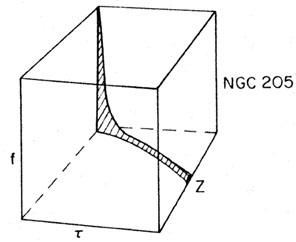Copyright © 1989 by Annual Reviews. All rights reserved
| Annu. Rev. Astron. Astrophys. 1989. 27:
139-59 Copyright © 1989 by Annual Reviews. All rights reserved |
5.5 NGC 205
Although usually classified as an elliptical galaxy, NGC 205, a close companion to M31, has long been known to be anomalous (13). More or less centered on the nucleus is a clear young population of stars, including about 100 resolved O and B stars and several dust clouds (62) and some H I (80). Ultraviolet IUE spectra reveal the presence of this young population also (132), as does visual spectrophotometry (104). Underlying it and spread out more widely in space is an old, metal-poor population. Figure 12 schematically shows the probable population history of this galaxy; a large fraction of its mass went into stars in an initial burst of star formation, followed by a small amount of continuing star formation up to the present with an attendant increase in heavy-element abundance. It should be pointed out, however, that much of the detail in Figure 12 is based more on guess than evidence. Present data do not clearly distinguish between a continuous, slow star formation rate or a sporadic, episodic pattern. Furthermore, the percentage of mass involved in the old population, its abundances, and the duration of its formation are also uncertain.

|
Figure 12. The probable population history of NGC 205. |